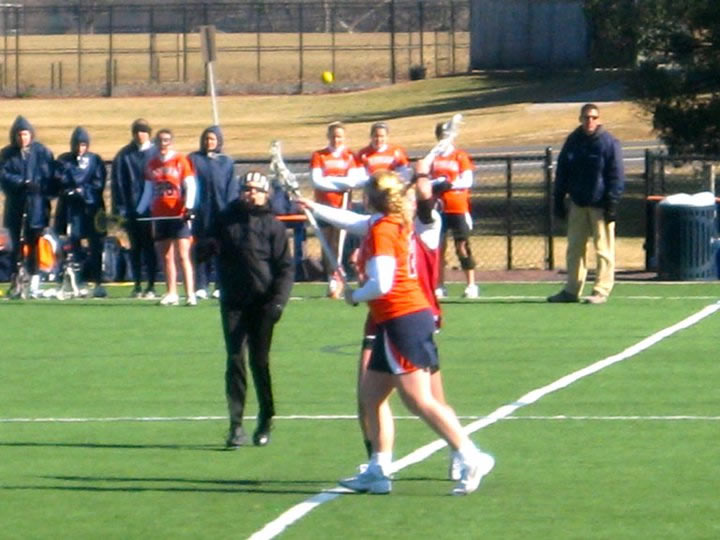HOME RESUME PORTFOLIO
BY JULIA BANKS
The game of women’s lacrosse has changed drastically within the past decade. Additional rules restricting the amount of contact and play has left players, spectators, and coaches frustrated.
Player and Coach Responses to the Rule Alterations
Bailey Beardsley, a sophomore attacker for the Gettysburg College Women’s Lacrosse program (ranked No. 2 in the nation among Division III teams), has been playing lacrosse for 11 years and has experienced the rule changes in the game first hand.

Bailey Beardsley in action during her freshman year at Gettysburg.
“When I first started playing we didn't have to wear goggles and we had no boundaries, now you have almost an unlimited option of goggles, and an unnecessary amount of rules,” Beardsley stated.
The game has been altered to make it safer for players on the field for female teams. More rules means more whistle blowing. Whenever an official, the players must immediately stop play. Kimi Brunot, a three-year starter for the Hood College Women’s team said “I think the refs need to let us play instead of blowing the whistle…It’s hard to get a play going if the whistle in constantly blowing.”

Kimi Brunot scooping up a ground ball during our season-opener this year at Waynesburg.
Though frustration from players is evident, the rules are developed to protect the gils on the field. When playing with metal sticks and throwing a hard rubber ball, injuries will occur. So, the NCAA and U.S. Lacrosse have made rules to make the sport safer.
Connie Weunchel, who has been coaching the Francis Scott Key High School girl’s lacrosse team for five years in addition to other youth and club teams in the Carroll County area, added her take on the rule changes: “For years I’ve thought that they (U.S. Lacrosse and NCAA) keep trying to make the game like the boys game. Now, it's become physical like the boys game and they don't know why. And now, they want to get away from that.”
Many women’s lacrosse players wish for the game to be similar to the men’s game. Whistles blowing throughout a contest “slows the momentum of the game down a lot,” Maria Moss said, a senior defender for the Hood College women’s lacrosse team.
The speediness of the men’s game attracts more fans- especially since players have ample opportunities to set up plays offensively. Since the momentum of their game is not constantly hindered by penalty calls, the men have a much more exciting match,
Don’t Shoot the Messenger
At the end of the day, who ends up getting blamed for the whistle-blowing? Well…the people who blow the whistles. That might be an obvious answer, but most referees do not physically make the rules.
The reality of it: these officials are often times merely the messengers of the rules made by the NCAA Women’s Lacrosse Rules Committee.
Michael White, who has been officiating NCAA women’s lacrosse games for the past 12 years, stated “At the end of the day we are here [officiating the game] to keep everyone safe. When I see a penalty I take my flag out and I try my best to let the play end, to give the girl a change to score.”
Helen and Sandy Moody, both have over 40 years of combined years of officiating women's lacrosse, agree that most officials do not intend to maliciously stop the flow of the game- they are trying to prevent injuries from occurring. It is their job, whether the players, spectators, or coaches like it or not. And, unfortunately, the NCAA does not seem to be getting lenient at all as far as contact goes.
Though some players still think one day the women’s game will be as thrilling and momentous as the men’s game, the rule changes reflect another plan. The NCAA sets these rules to ensure the safety of their players.
History and Background of Lacrosse
Lacrosse was played as a ritual in the Native American religion, and is considered the oldest sport in North America. The sport was a tool to prepare men for war, heal the sick, and even resolve conflict, according, U.S. Lacrosse. Contests sometimes involved thousands of players and consisted of balls made out of wood, deerskin, baked clay or stone, goalposts from trees and goals from rocks. The game has most certainly evolved into a safer game, but the heritage of lacrosse is extensive.
The earliest documentation of lacrosse was in 1630s by a Jesuit missionary names Jean de Brebeuf and English explorers in in the southeast region of Ontario, Canada, according to U.S. Lacrosse. These groups wrote about how large the playing fields were, the equipment used and how long they played for. They even noted how many people were on a team, but unfortunately they left out a description about how the game was played or any specific rules.
The game became more popular in the 1800s. Rules standardizing the dimensions of the field and amount of players on each team were made in 1867 by a Canadian dentist named George Beers.
Just a year later, New York University was the first college to adopt this activity as a collegiate sport for men. In the 1880s, high school teams started to arise as well.
The first women’s lacrosse game was played in 1890 and the St. Leonard’s School in Scotland. In 1926 the first women’s lacrosse team in the U.S. was established at the Bryn Mawr School in Baltimore, Md.
The rules of men’s and women’s lacrosse were the same until the 1930s, when protective gear was introduced and the men’s game changed. Women’s lacrosse, to this day, is seen to be truer to the game the Native Americans played centuries ago.
The rules and regulations of the women’s lacrosse have continued to change, while still maintaining the integrity of the tradition of lacrosse.
HOME RESUME PORTFOLIO



